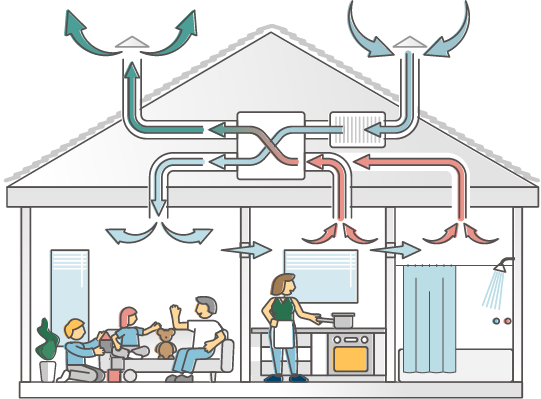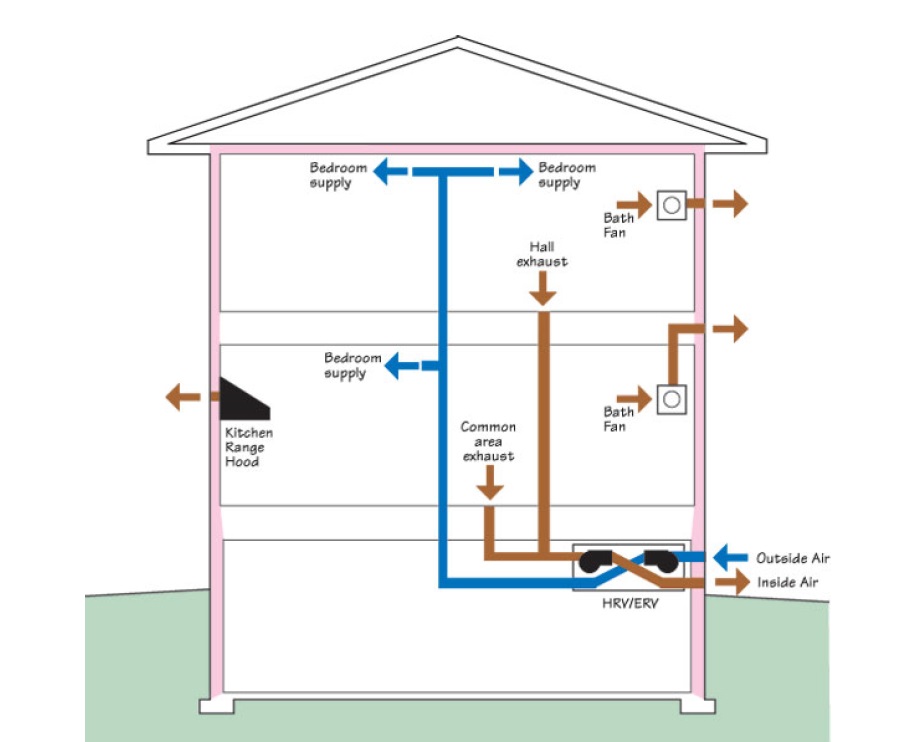Understanding the Relevance of Home Air Flow for a Healthier Living Setting
Home ventilation plays an important duty in keeping a healthy living setting. It helps with the exchange of indoor and outdoor air, which is very important for boosting air high quality. Without correct ventilation, homes can end up being reproducing grounds for allergens and contaminants. The consequences of inadequate air blood circulation can be significant. This brings up the questions of exactly how home owners can properly apply ventilation strategies to protect their wellness and wellness. Understanding these methods is critical.

The Fundamentals of Home Air Flow
Home ventilation offers as a crucial component of indoor air high quality and comfort. It entails the procedure of trading stagnant interior air with fresh outside air, therefore decreasing humidity and managing temperature. Appropriate air flow systems can include natural techniques, such as open windows and vents, as well as mechanical systems, such as exhaust followers and air exchangers. Effective home ventilation assists prevent problems like indoor mold and mildew development and the buildup of harmful bits. It additionally boosts overall power performance, as well-ventilated areas can keep comfy temperature levels with less reliance on heating and cooling systems. Comprehending the essentials of home ventilation is crucial for house owners seeking to produce a much healthier living atmosphere for themselves and their families.

Common Sources of Indoor Air Air Pollution

Although lots of might not understand it, interior air pollution can originate from different sources within a home. Common factors include volatile organic compounds (VOCs) discharged from paints, solvents, and cleaning products. Family appliances, such as gas ovens and fire places, can launch harmful gases like carbon monoxide and nitrogen dioxide. In addition, mold and mold flourish in moist areas, releasing spores that affect air high quality. Pet dog dander, allergen, and plant pollen can build up inside, more intensifying air pollution levels. Cigarette smoking inside generates toxic chemicals that stick around in the air. Finally, building products, including asbestos and formaldehyde, can off-gas damaging substances. Identifying these sources is necessary for maintaining a healthier interior setting and promoting efficient ventilation methods.
Wellness Impacts of Poor Ventilation
Indoor air contamination can have substantial wellness ramifications, especially when air flow is poor. Poor air flow can result in the buildup of harmful toxins, such as unstable organic compounds, mold, and particle matter. This buildup may cause breathing concerns, including bronchial asthma, allergic reactions, and chronic obstructive pulmonary condition. People may experience signs and symptoms like headaches, exhaustion, and inflammation of the eyes, nose, and throat. Prone populaces, such as kids and the senior, are at greater threat for extreme health and wellness impacts. Long-term direct exposure to inadequately ventilated settings can also contribute to much more serious conditions, including cardio conditions. As a result, ensuring correct air flow is important for preserving a healthy and balanced living environment and minimizing the risk of health complications related to indoor air pollution.
Reliable Air Flow Techniques for Your Home
Correct air flow is important for preserving a healthy and balanced interior atmosphere, and applying efficient techniques can substantially enhance air quality. Homeowners can begin by guaranteeing that exhaust followers are mounted in shower rooms and kitchen areas to get rid of excess moisture and odors. Opening windows routinely enables fresh air to distribute, particularly throughout moderate weather. Furthermore, utilizing air cleansers with HEPA filters can aid dig this catch air-borne contaminants. For homes with heating and cooling down systems, preserving heating and cooling systems and transforming filters consistently is essential for peak performance. Integrating natural ventilation techniques, such as cross-ventilation, can also improve air flow. Ultimately, securing any type of leaks in home windows and doors stops undesirable drafts, which can interrupt regulated air flow, eventually resulting in enhanced interior air quality and convenience.
Keeping Ideal Air High Quality Year-Round
To preserve suitable air high quality year-round, house owners have to embrace an aggressive method to managing their interior setting. Consistently keeping an eye on indoor air top quality is crucial; this includes checking for pollutants such as dirt, mold and mildew, and unstable organic substances (VOCs) Executing effective ventilation systems, such as exhaust fans and air purifiers, can substantially reduce air-borne pollutants. In addition, regular upkeep of HVAC systems guarantees peak efficiency and air flow. Home owners ought to also take into consideration moisture levels, as excessive wetness can lead to mold and mildew growth. Seasonal modifications may demand changes in air flow approaches to fit varying exterior air top quality. By focusing on these methods, house owners can develop a much healthier space, promoting overall health for all passengers throughout the year.
Frequently Asked Concerns
How Can I Tell if My Home Needs Better Ventilation?
To determine if a home needs far better air flow, one must observe indicators such as consistent moisture, mold and mildew growth, musty smells, condensation on windows, or raised allergy signs, indicating insufficient air flow and potentially bad indoor air quality.
What Are the Signs of Poor Indoor Air Quality?

Can Houseplants Improve Indoor Air Top Quality Successfully?
The efficiency of houseplants in boosting indoor air quality is questioned. While some research studies recommend they read this article can absorb contaminants and produce oxygen, their overall effect might be minimal compared to appropriate ventilation and air filtering systems.
Exactly how Commonly Should I Modification My Air Filters?
The regularity of air filter adjustments usually relies on use and filter kind. Typically, it is suggested to replace filters every 3 months, though families with allergies or pet dogs might need even more frequent adjustments for excellent performance.
Are There Any Kind Of Particular Air Flow Solutions for Allergic Reaction Sufferers?
Numerous ventilation systems, such as HEPA-filtered systems, efficiently reduce irritants airborne. Home Ventilation Melbourne. These systems catch pet dog, dust, and plant pollen dander, supplying allergy victims with a cleaner, much healthier interior setting while taking care of air high quality effectively
It facilitates the exchange of outdoor and interior air, which is crucial for enhancing air top quality. Home ventilation offers as a vital part of indoor air high quality and convenience. It entails the procedure of trading stale indoor air with fresh outside air, consequently reducing humidity and controlling temperature. Interior air contamination can have considerable health ramifications, especially when air flow is insufficient. Proper air flow is crucial for maintaining a healthy and balanced indoor setting, and implementing effective methods can substantially enhance air quality.